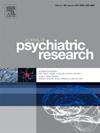年轻成年Sp4亚型小鼠精神分裂症相关表型的部分修复
IF 3.7
2区 医学
Q1 PSYCHIATRY
引用次数: 0
摘要
精神分裂症外显子组测序荟萃分析(SCHEMA)联盟发现,SP4基因一个拷贝的截断与精神分裂症(SCZ)的比值比为9.37(3.38-29.7)。人类SP4基因也是平行全基因组关联研究(GWAS)优先考虑的69个精神分裂症风险基因之一,也是图式和GWAS之间共有的两个精神分裂症风险基因之一,这表明SP4基因部分功能丧失的更微妙的常见变异可能参与了一般人群精神分裂症的发病机制。SP4也可能在许多其他精神分裂症风险基因的调控中起到网络中枢的作用。Sp4亚型小鼠的Sp4表达降低,再现了几种与精神分裂症相关的行为表型,如脉冲前抑制(PPI)缺陷、运动时对氯胺酮过敏和环境记忆缺陷。我们之前通过恢复胚胎发生期间前脑gaba能抑制神经元中Sp4的表达,证明了氯胺酮超敏反应的细胞特异性拯救。然而,尚不清楚在年轻成年Sp4亚型小鼠中恢复Sp4表达是否可以在这些表型仍在出现时挽救这些与精神分裂症相关的表型。这些研究对于评估SP4作为精神分裂症药物开发的潜在靶基因至关重要。本研究利用携带Cre重组酶的AAV.PHP.eB病毒,恢复了年轻成年Sp4亚型小鼠全脑内的Sp4表达。我们的初步研究表明,Sp4部分恢复减轻了成年雄性Sp4半形小鼠的PPI缺陷和氯胺酮运动超敏反应,但没有改善经AAV/PHP转导的Sp4半形小鼠的上下文记忆缺陷。携带Cre基因的eB病毒。为了验证我们的发现,需要大量的Sp4亚型小鼠进行拯救实验。本文章由计算机程序翻译,如有差异,请以英文原文为准。
Partial rescue of schizophrenia-related phenotypes in young adult Sp4 hypomorphic mice
The Schizophrenia Exome Sequencing Meta-Analysis (SCHEMA) Consortium found that truncation of one copy of the SP4 gene has an odds ratio of 9.37 (3.38–29.7) for schizophrenia (SCZ). Human SP4 gene is also one of the 69 schizophrenia-risk genes prioritized by parallel genome-wide association studies (GWAS) and one of the two schizophrenia-risk genes shared between the SCHEMA and the GWAS, suggesting that more subtle common variants of the SP4 gene with a partial loss-of-function are likely involved in the pathogenesis of schizophrenia in the general population of patients. SP4 may also act as a hub of network in the regulation of many other schizophrenia-risk genes. Sp4 hypomorphic mice that have reduced Sp4 expression recapitulate several behavioral phenotypes related to schizophrenia such as deficient prepulse inhibition (PPI), hypersensitivity to ketamine in locomotion, and deficient context memory. We previously demonstrated cell-specific rescue of ketamine hypersensitivity by restoring Sp4 expression in forebrain GABAergic inhibitory neurons during embryogenesis. However, it is unknown whether restoration of Sp4 expression in young adult Sp4 hypomorphic mice may rescue these schizophrenia-related phenotypes when these phenotypes are still emerging. Such studies are critical for evaluation of SP4 as a potential target gene for schizophrenia drug development. Here, we use AAV.PHP.eB virus carrying Cre recombinase to restore Sp4 expression in the whole brains of young adult Sp4 hypomorphic mice. Our preliminary studies suggested that Sp4 partial restoration attenuated PPI deficits and ketamine locomotor hypersensitivity in adult male Sp4 hypomorphic mice but did not improve deficient context memory in Sp4 hypomorphic mice transduced with AAV/PHP.eB virus carrying the Cre gene. A large cohort of Sp4 hypomorphic mice is needed for the rescue experiments to validate our findings.
求助全文
通过发布文献求助,成功后即可免费获取论文全文。
去求助
来源期刊

Journal of psychiatric research
医学-精神病学
CiteScore
7.30
自引率
2.10%
发文量
622
审稿时长
130 days
期刊介绍:
Founded in 1961 to report on the latest work in psychiatry and cognate disciplines, the Journal of Psychiatric Research is dedicated to innovative and timely studies of four important areas of research:
(1) clinical studies of all disciplines relating to psychiatric illness, as well as normal human behaviour, including biochemical, physiological, genetic, environmental, social, psychological and epidemiological factors;
(2) basic studies pertaining to psychiatry in such fields as neuropsychopharmacology, neuroendocrinology, electrophysiology, genetics, experimental psychology and epidemiology;
(3) the growing application of clinical laboratory techniques in psychiatry, including imagery and spectroscopy of the brain, molecular biology and computer sciences;
 求助内容:
求助内容: 应助结果提醒方式:
应助结果提醒方式:


